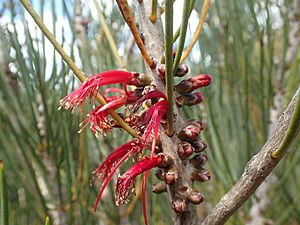Calothamnus tuberosus facts for kids
Quick facts for kids Calothamnus tuberosus |
|
|---|---|
 |
|
| Calothamnus tuberosus in the Australian National Botanic Gardens | |
| Scientific classification | |
| Genus: |
Calothamnus
|
| Species: |
tuberosus
|
| Synonyms | |
|
Melaleuca tuberosa (Hawkeswood) Craven & R.D.Edwards |
|
Calothamnus tuberosus is a unique plant from the Myrtaceae family, which also includes gum trees. It grows only in the south-west of Western Australia. This plant is quite stiff and prickly. It has long, round leaves and bright red flowers. You'll often find it growing near or right on top of granite rocks! It has special woody roots called a lignotuber and tuberous roots that help it survive.
Contents
What Does Calothamnus tuberosus Look Like?
Calothamnus tuberosus is a bushy shrub with many branches. It can grow to be about 2.5 metres (8 ft) tall. Its leaves are packed together at the ends of the branches. They are 50–80 millimetres (2–3 in) long and 1.0–2.5 millimetres (0.04–0.1 in) wide. The leaves are stiff and shaped like a cylinder, ending in a sharp, prickly point.
Flowers and Fruits
The flowers are a beautiful rich red color. They grow in small, dense groups among the leaves. You might also see them on older branches that have lost their leaves. Each flower has four thin, papery petals. These petals are about 3–4 millimetres (0.1–0.2 in) long and are orange to brown.
The stamens, which are the parts that hold pollen, are grouped into four claw-like bundles. Each bundle usually has 12 to 16 stamens. These bundles are about 22–28 millimetres (0.9–1 in) long.
Calothamnus tuberosus usually flowers from November to January. However, it can bloom at other times if the weather is right. After the flowers, the plant produces woody fruits. These fruits are almost round and are about 4–5 millimetres (0.16–0.20 in) wide. They are called capsules.
How Was This Plant Named?
The plant Calothamnus tuberosus was first officially described in 1984. This was done by a botanist named Trevor Hawkeswood. He published his description in a science journal called Nuytsia.
The second part of its scientific name, tuberosus, comes from a Latin word. It means "full of lumps." This name likely refers to its special tuberous roots.
Where Does Calothamnus tuberosus Grow?
This plant is found in specific areas of Western Australia. It grows on or very close to rocky granite outcrops. You can find it from the Barbalin area all the way to Peak Charles. These areas include different natural regions like the Avon Wheatbelt, Coolgardie, Esperance Plains, and Mallee.
Is This Plant Protected?
The Western Australian Government's Department of Parks and Wildlife keeps track of plants. They have classified Calothamnus tuberosus as "not threatened." This means it is not currently at risk of disappearing.



